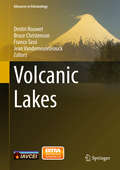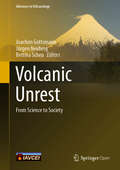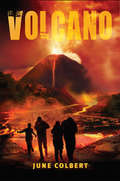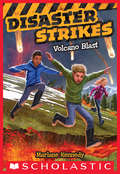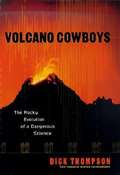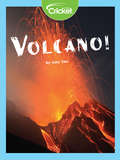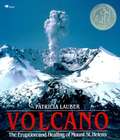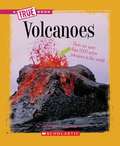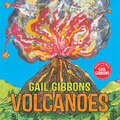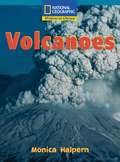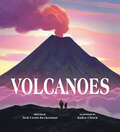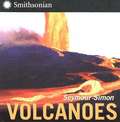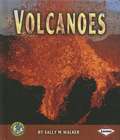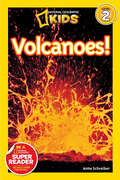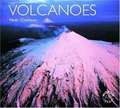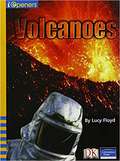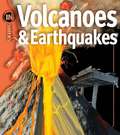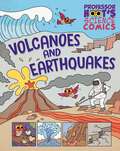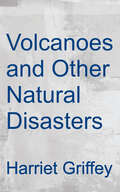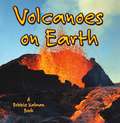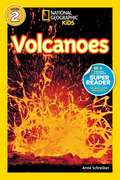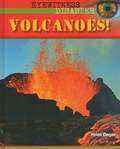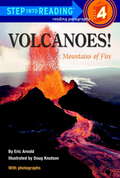- Table View
- List View
Volcanic Lakes
by Franco Tassi Dmitri Rouwet Bruce Christenson Jean VandemeulebrouckThis book aims to give an overview on the present state of volcanic lake research, covering topics such as volcano monitoring, the chemistry, dynamics and degassing of acidic crater lakes, mass-energy-chemical-isotopic balance approaches, limnology and degassing of Nyos-type lakes, the impact on the human and natural environment, the eruption products and impact of crater lake breaching eruptions, numerical modeling of gas clouds and lake eruptions, thermo-hydro-mechanical and deformation modeling, CO2 fluxes from lakes, volcanic lakes observed from space, biological activity, continuous monitoring techniques, and some aspects more. We hope to offer an updated manual on volcanic lake research, providing classic research methods, and point towards a more high-tech approach of future volcanic lake research and continuous monitoring.
Volcanic Unrest: From Science To Society (Advances In Volcanology Ser.)
by Joachim Gottsmann Jürgen Neuberg Bettina ScheuThis open access book summarizes the findings of the VUELCO project, a multi-disciplinary and cross-boundary research funded by the European Commission's 7th framework program. It comprises four broad topics:1. The global significance of volcanic unrest2. Geophysical and geochemical fingerprints of unrest and precursory activity3. Magma dynamics leading to unrest phenomena4. Bridging the gap between science and decision-makingVolcanic unrest is a complex multi-hazard phenomenon. The fact that unrest may, or may not lead to an imminent eruption contributes significant uncertainty to short-term volcanic hazard and risk assessment. Although it is reasonable to assume that all eruptions are associated with precursory activity of some sort, the understanding of the causative links between subsurface processes, resulting unrest signals and imminent eruption is incomplete. When a volcano evolves from dormancy into a phase of unrest, important scientific, political and social questions need to be addressed. This book is aimed at graduate students, researchers of volcanic phenomena, professionals in volcanic hazard and risk assessment, observatory personnel, as well as emergency managers who wish to learn about the complex nature of volcanic unrest and how to utilize new findings to deal with unrest phenomena at scientific and emergency managing levels. This book is open access under a CC BY license.
Volcanism and Global Environmental Change
by Anja Schmidt Kirsten E. Fristad Linda T. Elkins-Tanton Anja Schmidt Kirsten E. FristadCovering a key connection between geological processes and life on Earth, this multidisciplinary volume describes the effects of volcanism on the environment by combining present-day observations of volcanism and environmental changes with information from past eruptions preserved in the geologic record. The book discusses the origins, features and timing of volumetrically large volcanic eruptions; methods for assessing gas and tephra release in the modern day and the palaeo-record; and the impacts of volcanic gases and aerosols on the environment, from ozone depletion to mass extinctions. The significant advances that have been made in recent years in quantifying and understanding the impacts of present and past volcanic eruptions are presented and review chapters are included, making this a valuable book for academic researchers and graduate students in volcanology, climate science, palaeontology, atmospheric chemistry, and igneous petrology.
Volcano
by June ColbertSara is fifteen and secretly in love with Kel Pearson. Her dad is a Meatball. Kel?s dad is a Meatball too. `Meatballs? like to jump into earthquakes and climb inside volcanoes to take their temperatures. When they clamber out, shoes burning and hair smoking, they pass their findings on to Coneheads. `Coneheads? analyse data and make recommendations to local governments. Together they make up an `AusDAR? team ? Disaster Assessment and Relief (Australian Division) ? experts in Disaster Casualty Minimisation. They?ve just been asked to go to the exotic Andes to gauge the safety of the new gas and oil pipeline being dug through the base of a sleepy little extinct volcano called Mt Cumbal. They are all set for the adventure of a lifetime ? after all, the volcano is in no danger of erupting. But what about that murky, brown water coming out of the tap in Sara?s caravan? It?s not supposed to smell like sulphur ? June Colbert, bestselling author of THE KING OF LARGE and THE LAST BOY, masterfully weaves together teenage themes of identity, pride, secret `crushes? and the sense of belonging in her well-researched, detailed and fast-paced novel VOLCANO.
Volcano Blast: Volcano Blast (Disaster Strikes #4)
by Marlane KennedyWhen disaster strikes, the only thing you can count on is yourself!Noah and Emma Burton have traded the sand and surf of their Hawaiian home for a chilly stay in Alaska, and Noah isn't happy about it. His father may be a volcano expert, but why did they have to travel to the coldest, grayest place on earth when there are millions of volcanoes near Honolulu? Noah thinks he's in for the most boring vacation of his life.He couldn't have been more wrong! A day trip to a remote island turns deadly when a once-dormant volcano suddenly sputters to life in an eruption of epic proportions. Now Noah, Emma, and their new neighbor Alex must fight to survive rivers of molten lava and clouds of toxic ash if they want to make it off the island alive....
Volcano Cowboys: The Rocky Evolution of a Dangerous Science
by Dick ThompsonTwenty years ago, Mt. St. Helens, in Washington State, "blew. " It was the volcano's first eruption in recorded time, although as early as 1978 a team of scientists from the US Geological Survey had labeled it "the most dangerous volcano in the Cascade Range. " In June 1991, Mt. Pinatubo in the Philippines spewed forth its own mix of ash, gases, mud, lava, and all the other debris that had been building within the mountain for centuries. Between those two events, USGS scientists had been working at warp speed to learn more about predicting violent eruptions. Data from the nation's only Volcano Center was not helpful. Work there centered on volcanoes that responded to interior pressure by quietly releasing a slow-moving flow of lava, rather than spewing its entrails out in a blast. Survey members were presented with a rare opportunity when Mt. St. Helens showed signs of activity. Camped on the mountains flanks, daring the crater itself, they dug out rocks, tended recorders, began to learn how to use newly developed instruments. Here was an active volcano, believed to be on the verge of eruption by some, if not all, experts. Along with new instruments they had computer programs that saved them days and weeks of work. They learned techniques that revealed the dates of previous major eruptions and provided patterns for future predictions. After the eruption, studying Mt. St. Helens and other volcanoes, they learned more and more. By the time a newly-active Pinatubo threatened tens of thousands of villagers and the U. S. military's Clark Air Force Base, the men of the USGS were far better able to feel secure in urging local authorities and the Air Force brass to evacuate. It was still a gamble, but the odds were far better. And the work goes on. Thompson, a veteran science reporter for Time Magazine, spent many hours with the relative handful of scientists whom he calls "volcano cowboys. " (Considering their lifestyle and their rugged "laboratories" - the volcanoes themselves - the sobriquet is earned. ) They have loaned him their field notes, and one geologist gave him his as yet unpublished autobiography. The vivid material and Thompson's skill in bringing a good story to life has resulted in a book that celebrates these "cowboys" their tough and hazardous lives and the often harrowing decisions they must make.
Volcano!
by Amy TaoWhen volcanoes blow their top, watch out! They can blast out dangerous lava, rocks, ash, and steam that can contain clouds of poisonous gas. But when lava cools, it becomes rock, which in turn creates new land.
Volcano: The Eruption and Healing of Mount St. Helens
by Patricia Lauber<b>May 18, 1980, 8:32 A. M. :</b> An earthquake suddenly triggered an avalanche on Mount St. Helens, a volcano in southern Washington State. Minutes later, Mount St. Helens blew the top off its peak and exploded into the most devastating volcanic eruption in U. S. history. <P>What caused the eruption? What was left when it ended? What did scientists learn in its aftermath? In this extraordinary photographic essay, Patricia Lauber details the Mount St. Helens eruption and the years following. Through this clear accurate account, readers of all ages will share the awe of the scientists who witnessed both the power of the volcano and the resiliency of life.<P><P> <b>Newbery Medal Honor book</b>
Volcanoes
by Elaine LandauWhat makes the earth quake, rivers flood, and volcanoes blow their tops? How do natural forces become natural disasters? Buckle your seatbelts and get ready for a bumpy ride to the center of the earth for a look at some of the wildest phenomena in the history of earth science!
Volcanoes
by Gail GibbonsRumbling, hissing, shaking. . .a volcano is about to erupt! Learn all about volcanoes, from tectonic plates to what do when there is a volcanic warning, in this primer for young readers. Did you know there are four main types of volcanoes? Or that volcanoes are classified as active, dormant, or extinct? The Devil&’s Tower in Wyoming is an extinct volcano. It&’s about 40.5 million years old!Gail Gibbons explores the hows and whys of volcanoes, using direct sentences, maps, infographics, and illustrations. Readers will learn about the four layers of the earth, the basics of plate tectonics, the different types of volcanoes, and much more. Fully vetted by a working volcanologist, this book is perfect for earth science lovers and aspiring volcanologists. This title is part of the Explore the World . . . with Gail Gibbons series, which promotes active learning, good citizenship, and student leadership.
Volcanoes
by National Geographic LearningThis book shows where and how volcanoes form and what happens when they erupt.
Volcanoes
by Nell Cross BeckermanThe team behind the acclaimed book Caves returns with an enticing exploration of one of the most explosive wonders on the planet--Volcanoes!A rumble. A tremble. A grumble. Growing, growling, getting hot. When will it...POP?!Using evocative storytelling, Nell Cross Beckerman leads children on an adventure through the radioactive wonders that are volcanoes. From deep down on the ocean floor to extraterrestrial volcanoes, Beckerman guides readers with dramatic, poetic language. Nonfiction text on every page allows for deeper understanding of the topic.Illustrator Kalen Chock's stunning illustrations have been praised as "atmospheric" and "striking," and readers will be delighted as each new page brings a new surprise. Extensive backmatter includes an author's note, additional information on the types of volcanic eruptions and the questions volcanologists are trying to answer, and additional facts. An ideal choice for nature lovers, future explorers, and fans of Jason Chin and Kate Messner.
Volcanoes
by Seymour Simon<P>Exceptional nonfiction for children from two of the most trusted names in science education: Seymour Simon and the Smithsonian Institution. <P>[This text is listed as an example that meets Common Core Standards in English language arts in grades 4-5 at http://www.corestandards.org.]
Volcanoes (Early Bird Earth Science)
by Sally M. WalkerThis book introduces young readers to volcanoes--what they are, how they form, and how they affect people.
Volcanoes (Readers)
by Anne SchreiberThe cool story of volcanoes will intrigue kids and adults alike. Hot melted rock from the middle of our planet forces its way up through cracks in the Earth&’s crusts, exploding violently and sometimes unexpectedly in volcanic fury that can terrorize populations for months, even years. Anne Schreiber&’s narrative gives readers a little of the science, a little of the history, and a lot of the action. National Geographic photography fires the imagination on dramatic spreads alive with vivid images of lava, ash, molten rock, weird rocks, and steaming seawater.
Volcanoes (Worldlife Library)
by Peter ClarksonWhat are volcanoes? Where and why do they happen? The aim of this book is to answer these questions and to explain one of the great natural wonders of the Earth. Volcano! Just the mention of the word creates a mental picture, which varies with the listener's own perception. An artist may think of the classical shape of Mount Fuji; a historian may recall the destruction of Pompeii by Vesuvius; a geologist may speculate about the gas content of the lava in relation to its viscosity; a newspaper editor may see the scope for spectacular photographs and stories of human suffering and heroism that will boost newspaper circulation. Whatever thoughts spring to mind, nobody can be but impressed by the awful power of a volcanic eruption and the devastation that may be caused.
Volcanoes And Earthquakes (INsiders)
by Ken RubinINsiders brings volcanoes & earthquakes to life, with the most up-to-date information stimulating minds and imaginations in a whole new way.
Volcanoes and Earthquakes
by Mary EltingDiscusses how earthquakes and volcanic eruptions occur and how they can be predicted.
Volcanoes and Earthquakes (Professor Hoot's Science Comics #4)
by Jen GreenEvery day brings a new adventure for Professor Hoot - and a new learning experience. There's a plume of smoke in the distance, it looks like a volcano has erupted! Professor Hoot sets off to investigate all about volcanoes and how they are formed, all while avoiding smoky feathers! Discover other natural distasters, such as earthquakes, tsunamis and landslides - and what to do in such events.An entertaining comic strip approach to KS1 science topics, Professor Hoot's Science Comics are accessible and full of fun. Each book is an adventure and a chance for readers to learn something new, before testing their knowledge at the end of each book in Professor Hoot's quiz. Collect each adventure: Big Machines; Dangerous Animals; Dinosaurs; Robots and AI; Space; Volcanoes and Earthquakes.
Volcanoes and Other Natural Disasters (Dk Readers Series Dorling Kindersley Readers)
by Dorling Kindersley Publishing Staff Harriet GriffeyDescribes natural disasters which have occurred in various places throughout the world including the eruption of Vesuvius in 79 A.D., the Yellow River flood in 1887, and the Australian bush fires in 1983.
Volcanoes on Earth
by Bobbie KalmanDramatic photographs of spewing and flowing lava will capture the attention of any child. in this fantastic new book, children will be excited to learn what a volcano is and what makes it erupt. Simple explanations describe the different kinds of volcanoes, including cinder, cone-shaped, shield, and composite as well as the different kinds of lava and the land formations they create on land and under the ocean. Other topics include the reason volcanoes often erupt during earthquakes, why giant tsunami waves are sometimes created by underwater earthquakes, and how volcanoes are studied in order to predict and prepare for eruptions. Children will also enjoy making their own volcano out of household materials.
Volcanoes!
by Anne SchreiberThe cool story of volcanoes will intrigue kids and adults alike. Hot melted rock from the middle of our planet forces its way up through cracks in the Earth’s crusts, exploding violently and sometimes unexpectedly in volcanic fury that can terrorize populations for months, even years. Anne Schreiber’s narrative gives readers a little of the science, a little of the history, and a lot of the action.
Volcanoes!
by Helen DwyerProduces the facts on volcanoes, like what is a volcano, where they are found, and basic information on the same
Volcanoes!: Mountains of Fire (Step into Reading)
by Eric ArnoldA volcano could be called a sleeping mountain--that is, until it wakes up! What is it like to witness the eruption of one of nature's majestic time bombs? Young readers can learn what makes volcanoes "tick," and read about some of the most famous eruptions in history.
